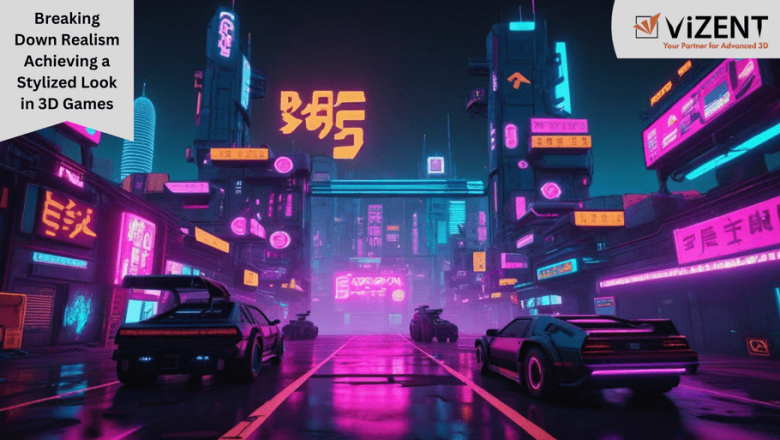views
In the world of video game development, realism has long been a benchmark for visual excellence. However, not every game seeks to mimic the physical world. Many developers aim to achieve a stylized look, offering a unique and artistic visual experience that sets their creations apart. This approach not only fosters creativity but also enables developers to explore distinct gameplay narratives. Let’s dive into how to achieve a stylized aesthetic in 3D modeling games while maintaining visual cohesion and gameplay appeal.
Understanding Stylized Visuals in 3D Games
Stylized visuals prioritize artistic expression over photorealistic accuracy. Instead of replicating real-world environments and objects, this style exaggerates or simplifies features to create a specific mood or theme. Iconic examples include cartoonish characters, surreal environments, and painterly textures seen in games like Fortnite, Zelda: Breath of the Wild, and Hades. The charm of stylized games lies in their ability to immerse players in unique worlds that feel both imaginative and cohesive.
Achieving such visuals requires a careful balance between creativity and technical execution. Each element, from character models to game assets, must contribute to the overall aesthetic.
Designing Characters with Stylization
Stylized characters often serve as the centerpiece of a game’s visual design. When creating them, developers focus on:
- Exaggerated Proportions: Many stylized characters feature oversized heads, elongated limbs, or expressive facial features. This exaggeration helps convey personality and emotion more effectively.
- Simplified Details: Unlike photorealistic characters that require intricate detailing, stylized characters rely on bold shapes and simple textures to stand out.
- Consistent Art Direction: Ensuring all characters follow the same design language helps maintain visual consistency across the game.
For example, in 3D modeling games, developers often create characters with hand-painted textures to evoke a whimsical or storybook-like quality. Tools like Blender, ZBrush, and Substance Painter are instrumental in achieving this.
Creating Stylized 3D Game Environments
Game environments play a crucial role in establishing the overall mood. When designing 3D game environments for a stylized game, consider the following:
- Bold Color Palettes: Stylized environments often use vibrant or thematic color schemes to evoke specific emotions. For instance, a magical forest might feature glowing blues and purples, while a desert setting might rely on warm oranges and yellows.
- Simplified Geometry: Like characters, environments benefit from simplified shapes. Mountains, trees, and buildings are often crafted with exaggerated or angular forms to enhance the stylized effect.
- Texture Design: Hand-painted or procedural textures add depth to stylized environments without relying on photorealistic details. These textures often include artistic flourishes like brushstrokes or gradients.
For developers, tools like Unreal Engine or Unity provide the flexibility to implement these design elements efficiently. By combining detailed 3D game environments with consistent lighting and shading, developers can create immersive worlds that resonate with players.
Building Game Assets for a Stylized Look
Game assets, such as props, weapons, and vehicles, must align with the chosen visual style. To achieve this:
- Define a Clear Style Guide: Before creating assets, establish guidelines that dictate proportions, texture styles, and color usage. This ensures every asset fits seamlessly into the game.
- Focus on Silhouettes: A strong silhouette ensures assets are instantly recognizable, even from a distance. This is particularly important in fast-paced games.
- Experiment with Materials: Stylized materials, like glossy finishes for futuristic objects or rough textures for medieval props, add character to game assets.
Each asset’s design must complement the overall game world. For instance, in a stylized pirate game, barrels, cannons, and ships might feature exaggerated curves and whimsical details that match the environment’s tone.
The Role of Lighting and Post-Processing
Lighting and post-processing are essential in enhancing the stylized look of 3D modeling games. These techniques can:
- Amplify Visual Drama: Use lighting to highlight specific areas or create striking contrasts. Cel-shading, for instance, is a popular technique that emphasizes outlines and adds a cartoon-like feel.
- Create Atmosphere: Fog, bloom effects, and color grading can transform a scene, making it feel more vibrant or mysterious.
- Maintain Consistency: Stylized games often rely on unified lighting setups to ensure every element appears cohesive.
Unreal Engine’s post-processing features or Unity’s Shader Graph are excellent tools for achieving these effects.
Balancing Performance with Stylization
One advantage of stylized visuals is their ability to perform well on a range of devices. Unlike photorealistic graphics, which often require high-end hardware, stylized games can optimize their assets for lower processing power without sacrificing quality.
To achieve this balance:
- Optimize Models: Use fewer polygons and simplify geometry for non-essential elements.
- Use Efficient Textures: Compress textures where possible and reuse materials across multiple assets.
- Simplify Shaders: Stylized shaders often demand less processing power compared to realistic ones, making them ideal for mobile and indie games.
Why Choose Stylized Over Realistic?
Stylized visuals offer several advantages over realism in game development:
- Timeless Appeal: Stylized games age more gracefully, as their artistic charm doesn’t rely on cutting-edge technology.
- Lower Production Costs: Developing photorealistic visuals requires extensive resources and time, whereas stylized designs allow for more creative freedom with fewer constraints.
- Distinct Identity: A unique visual style helps a game stand out in a crowded market.
- Broader Accessibility: Stylized games often cater to a wider audience, appealing to players of all ages.
Conclusion
Achieving a stylized look in 3D modeling games requires a harmonious blend of artistic vision and technical expertise. From designing expressive characters and immersive 3D game environments to crafting unique game assets, every element plays a role in creating a memorable visual experience. By focusing on creativity, consistency, and optimization, developers can produce games that not only captivate players but also stand the test of time. Whether you’re an indie creator or part of a larger studio, embracing stylization can lead to innovative and unforgettable gaming experiences.






















Comments
0 comment